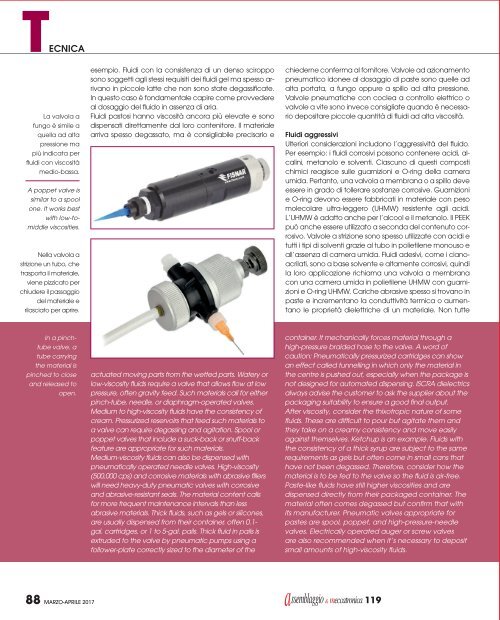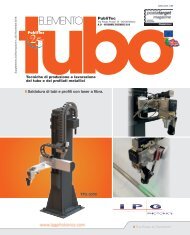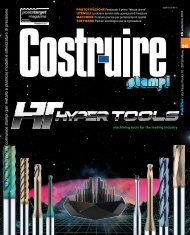ASSEMBLAGGIO_n119_MARZO_APRILE_2017
Create successful ePaper yourself
Turn your PDF publications into a flip-book with our unique Google optimized e-Paper software.
TECNICA<br />
La valvola a<br />
fungoèsimilea<br />
quella ad alta<br />
pressione ma<br />
più indicata per<br />
fluidi con viscosità<br />
medio-bassa.<br />
A poppet valve is<br />
similar to a spool<br />
one. It works best<br />
with low-tomiddle<br />
viscosities.<br />
Nella valvola a<br />
strizione un tubo, che<br />
trasporta il materiale,<br />
viene pizzicato per<br />
chiudere il passaggio<br />
del materiale e<br />
rilasciato per aprire.<br />
esempio. Fluidi con la consistenza di un denso sciroppo<br />
sono soggetti agli stessi requisiti dei fluidi gel ma spesso arrivano<br />
in piccole latte che non sono state degassificate.<br />
In questo caso è fondamentale capire come provvedere<br />
al dosaggio del fluido in assenza di aria.<br />
Fluidi pastosi hanno viscosità ancora più elevate e sono<br />
dispensati direttamente dal loro contenitore. Il materiale<br />
arriva spesso degassato, ma è consigliabile precisarlo e<br />
chiederne conferma al fornitore. Valvole ad azionamento<br />
pneumatico idonee al dosaggio di paste sono quelle ad<br />
alta portata, a fungo oppure a spillo ad alta pressione.<br />
Valvole pneumatiche con coclea a controllo elettrico o<br />
valvole a vite sono invece consigliate quando è necessario<br />
depositare piccole quantità di fluidi ad alta viscosità.<br />
Fluidi aggressivi<br />
Ulteriori considerazioni includono l’aggressività del fluido.<br />
Per esempio: i fluidi corrosivi possono contenere acidi, alcalini,<br />
metanolo e solventi. Ciascuno di questi composti<br />
chimici reagisce sulle guarnizioni e O-ring della camera<br />
umida. Pertanto, una valvola a membrana o a spillo deve<br />
essere in grado di tollerare sostanze corrosive. Guarnizioni<br />
e O-ring devono essere fabbricati in materiale con peso<br />
molecolare ultra-leggero (UHMW) resistente agli acidi.<br />
L’UHMW è adatto anche per l’alcool e il metanolo. Il PEEK<br />
può anche essere utilizzato a seconda del contenuto corrosivo.<br />
Valvole a strizione sono spesso utilizzate con acidi e<br />
tutti i tipi di solventi grazie al tubo in polietilene monouso e<br />
all’assenza di camera umida. Fluidi adesivi, come i cianoacrilati,<br />
sono a base solvente e altamente corrosivi, quindi<br />
la loro applicazione richiama una valvola a membrana<br />
con una camera umida in polietilene UHMW con guarnizioni<br />
e O-ring UHMW. Cariche abrasive spesso si trovano in<br />
paste e incrementano la conduttività termica o aumentano<br />
le proprietà dielettriche di un materiale. Non tutte<br />
In a pinchtube<br />
valve, a<br />
tube carrying<br />
the material is<br />
pinched to close<br />
and released to<br />
open.<br />
actuated moving parts from the wetted parts. Watery or<br />
low-viscosity fluids require a valve that allows flow at low<br />
pressure, often gravity feed. Such materials call for either<br />
pinch-tube, needle, or diaphragm-operated valves.<br />
Medium to high-viscosity fluids have the consistency of<br />
cream. Pressurized reservoirs that feed such materials to<br />
a valve can require degassing and agitation. Spool or<br />
poppet valves that include a suck-back or snuff-back<br />
feature are appropriate for such materials.<br />
Medium-viscosity fluids can also be dispensed with<br />
pneumatically operated needle valves. High-viscosity<br />
(500,000 cps) and corrosive materials with abrasive fillers<br />
will need heavy-duty pneumatic valves with corrosive<br />
and abrasive-resistant seals. The material content calls<br />
for more frequent maintenance intervals than less<br />
abrasive materials. Thick fluids, such as gels or silicones,<br />
are usually dispensed from their container, often 0.1-<br />
gal. cartridges, or 1 to 5-gal. pails. Thick fluid in pails is<br />
extruded to the valve by pneumatic pumps using a<br />
follower-plate correctly sized to the diameter of the<br />
container. It mechanically forces material through a<br />
high-pressure braided hose to the valve. A word of<br />
caution: Pneumatically pressurized cartridges can show<br />
an effect called tunnelling in which only the material in<br />
the centre is pushed out, especially when the package is<br />
not designed for automated dispensing. ISCRA dielectrics<br />
always advise the customer to ask the supplier about the<br />
packaging suitability to ensure a good final output.<br />
After viscosity, consider the thixotropic nature of some<br />
fluids. These are difficult to pour but agitate them and<br />
they take on a creamy consistency and move easily<br />
against themselves. Ketchup is an example. Fluids with<br />
the consistency of a thick syrup are subject to the same<br />
requirements as gels but often come in small cans that<br />
have not been degassed. Therefore, consider how the<br />
material is to be fed to the valve so the fluid is air-free.<br />
Paste-like fluids have still higher viscosities and are<br />
dispensed directly from their packaged container. The<br />
material often comes degassed but confirm that with<br />
its manufacturer. Pneumatic valves appropriate for<br />
pastes are spool, poppet, and high-pressure-needle<br />
valves. Electrically operated auger or screw valves<br />
are also recommended when it’s necessary to deposit<br />
small amounts of high-viscosity fluids.<br />
88 <strong>MARZO</strong>-<strong>APRILE</strong> <strong>2017</strong> & meccatronica 119





